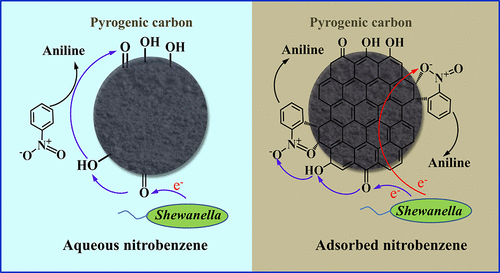当前位置:
X-MOL 学术
›
Environ. Sci. Technol.
›
论文详情
Our official English website, www.x-mol.net, welcomes your
feedback! (Note: you will need to create a separate account there.)
Role of Pyrogenic Carbon in Parallel Microbial Reduction of Nitrobenzene in the Liquid and Sorbed Phases.
Environmental Science & Technology ( IF 10.8 ) Pub Date : 2020-06-11 , DOI: 10.1021/acs.est.0c01061 Hefei Wang 1, 2 , He-Ping Zhao 1 , Lizhong Zhu 1, 2
Environmental Science & Technology ( IF 10.8 ) Pub Date : 2020-06-11 , DOI: 10.1021/acs.est.0c01061 Hefei Wang 1, 2 , He-Ping Zhao 1 , Lizhong Zhu 1, 2
Affiliation

|
Surface functional groups and graphitic carbons make up the electroactive components of pyrogenic carbon. The role of pyrogenic carbon with different contents of electroactive components in mediating electron transfer in biochemical reactions has not been systematically studied. Here, we determined the electron exchange capacity (EEC) of pyrogenic carbon to be 0.067–0.120 mmol e–·(g of pyrogenic carbon)−1, and the maximum electrical conductivity (EC) was 4.85 S·cm–1. Nitrobenzene was simultaneously reduced in both the liquid and sorbed phases by Shewanella oneidensis MR-1 in the presence of pyrogenic carbon. Pyrogenic carbon did not affect the aqueous nitrobenzene reduction, and the reduction of sorbed nitrobenzene was much slower than that of the aqueous species. Enhancing contents of oxygenated functional moieties in pyrogenic carbon with HNO3 oxidation elevated bioreduction rates of the aqueous and sorbed species. Anthraquinone groups were deemed as the most likely oxygenated functional redox compounds on the basis of both voltammetric curve tests and spectroscopic analysis. The reactivity of pyrogenic carbon in mediating the reduction of sorbed nitrobenzene was positively correlated with its EC, which was demonstrated to be related to condensed aromatic structures. This work elucidates the mechanism for pyrogenic carbon-mediated biotransformation of nitrobenzene and helps properly evaluate the role of pyrogenic carbon in biogeochemical redox processes happening in nature.
中文翻译:

热解碳在液相和吸附相中微生物平行还原硝基苯中的作用。
表面官能团和石墨碳构成热解碳的电活性成分。尚未系统研究具有不同电活性成分含量的热解碳在介导生化反应中的电子转移中的作用。在这里,我们确定热解碳的电子交换容量(EEC)为0.067-0.120毫摩尔ë - ·(克热解碳的)-1,最大导电率(EC)为4.85 S·厘米-1。沙瓦氏菌同时在液相和吸附相中还原硝基苯在热解碳存在下的MR-1。热解碳不影响水溶液中硝基苯的还原,吸附硝基苯的还原要比水性物种的还原慢得多。用HNO 3提高热解碳中氧化官能团的含量氧化提高了水和吸附物质的生物还原速率。根据伏安曲线测试和光谱分析,蒽醌基团被认为是最可能的氧化功能氧化还原化合物。热解碳在介导的硝基苯吸附还原反应中的反应性与其EC呈正相关,这被证明与稠合的芳族结构有关。这项工作阐明了热解碳介导的硝基苯生物转化的机理,并有助于正确评估热解碳在自然界发生的生物地球化学氧化还原过程中的作用。
更新日期:2020-07-21
中文翻译:

热解碳在液相和吸附相中微生物平行还原硝基苯中的作用。
表面官能团和石墨碳构成热解碳的电活性成分。尚未系统研究具有不同电活性成分含量的热解碳在介导生化反应中的电子转移中的作用。在这里,我们确定热解碳的电子交换容量(EEC)为0.067-0.120毫摩尔ë - ·(克热解碳的)-1,最大导电率(EC)为4.85 S·厘米-1。沙瓦氏菌同时在液相和吸附相中还原硝基苯在热解碳存在下的MR-1。热解碳不影响水溶液中硝基苯的还原,吸附硝基苯的还原要比水性物种的还原慢得多。用HNO 3提高热解碳中氧化官能团的含量氧化提高了水和吸附物质的生物还原速率。根据伏安曲线测试和光谱分析,蒽醌基团被认为是最可能的氧化功能氧化还原化合物。热解碳在介导的硝基苯吸附还原反应中的反应性与其EC呈正相关,这被证明与稠合的芳族结构有关。这项工作阐明了热解碳介导的硝基苯生物转化的机理,并有助于正确评估热解碳在自然界发生的生物地球化学氧化还原过程中的作用。











































 京公网安备 11010802027423号
京公网安备 11010802027423号